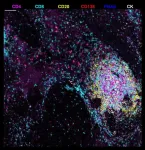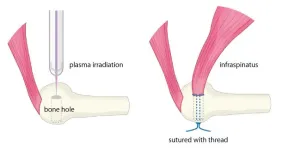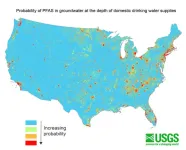(Press-News.org) **EMBARGOED FOR RELEASE UNTIL OCT. 25 AT 5 A.M. ET**
A newly described stage of a lymph node-like structure seen in liver tumors after presurgical immunotherapy may be vital to successfully treating patients with hepatocellular carcinoma, according to a study by researchers from the Johns Hopkins Kimmel Cancer Center.
The study, published Oct. 25 in Nature Immunology, provides new information about lymph node-like structures called tertiary lymphoid structures. These structures, which are highly organized collections of immune B and T cells, are found in some patients treated with immune checkpoint inhibitors — substances that reactivate the body’s natural anti-cancer immunity — and are associated with greater treatment response. However, researchers are still trying to fully understand what these structures contribute to immune responses to cancer, how they change over time, and what finding them in tumors means for patients.
The study identifies a previously unknown form of these structures. Patients who have more of these structures are less likely to have a recurrence of their cancer after surgery, the investigators found.
“We identified the life cycle of tertiary lymphoid structures in patients with liver cancer, and the takeaway is that these structures may be very important in the generation of anti-tumor immunity and may increase the likelihood of curing the cancer,” says Mark Yarchoan, M.D., an associate professor of oncology at the Johns Hopkins Kimmel Cancer Center.
Yarchoan and his colleagues previously conducted the first clinical trials of immunotherapy before surgery for hepatocellular carcinoma. Only some of the patients were cured with this approach, and the investigators have been trying to understand why.
“One of the things that struck us when we looked at these tumors was that patients who were responding to immunotherapy had tertiary lymphoid structures,” he says. Like lymph nodes, the structures have infection-fighting immune B cells in the middle and tumor-killing immune T cells on the outside. “We wanted to learn what these structures are doing.”
They found that tumors with more tertiary lymphoid structures after immunotherapy shrunk more and were less likely to reoccur after surgical removal. Tumors without these structures, by contrast, didn’t shrink and were more likely to come back after surgery. Tertiary lymphoid structures that grew in the center of tumors rather than around the edges were particularly beneficial.
When the investigators looked at biopsies taken before and after immunotherapy, they found that patients who developed these structures had what looked like precursors of tertiary lymphoid structures prior to beginning therapy. When the study’s lead author, Daniel Shu, M.D., then a medical oncology fellow at Johns Hopkins, examined sites where the patients’ tumors had been eliminated, he discovered a transformation in the tertiary lymphoid structures remaining at the site.
“In tumors where immunotherapy had the greatest effect, we found another form of tertiary lymphoid structure that has not been seen before. In this form, there was dispersion of B cells and apparent retention of so-called T cell zones, where T cells are primed to identify antigens,” says Shu, now at the University of Maryland School of Medicine. “These same patients tend to have the greatest benefit from immunotherapy given in this way. While a lot more work needs to be done, our hypothesis is that this form is a late stage of tertiary lymphoid structure that may contribute to long-term benefit we are seeing in these patients.”
The next step for the team is to determine if they can induce the formation of tertiary lymphoid structures in patients who don’t develop them on their own after starting immunotherapy. They also plan to look at how different combinations of immunotherapies or other presurgical therapies affect tertiary lymphoid structure formation and patient outcomes. The discovery also may have implications for other types of cancer, since the new form of tertiary lymphoid structure reported here was also seen by the authors in two other types of tumors known to respond to immunotherapy.
The study was a collaborative effort of the imCORE Network, and a co-leader of the study was Elana Fertig, Ph.D., a professor of oncology and biomedical engineering; division director of oncology quantitative sciences; and co-director of the Convergence Institute at Johns Hopkins. Study co-authors include Won Jin Ho, Luciane Kagohara, Alexander Girgis, Sarah Shin, Ludmila Danilova, Jae Lee, Dimitrios Sidiropoulos, Sarah Mitchell, Kabeer Munjal, Kathryn Howe, Kayla Bendinelli, Emma Kartalia, Hanfei Qi, Guanglan Mo, Janelle Montagne, James Leatherman, Tamara Lopez-Vidal, Qingfeng Zhu, Amanda Huff, Xuan Yuan, Alexei Hernandez, Erin Coyne, Neeha Zaidi, Daniel Zabransky, Logan Engle, Aleksandra Ogurtsova, Marina Baretti, Daniel Laheru, Jennifer Durham, Hao Wang, Joel Sunshine, Julie Stein Deutsch, Janis Taube, Robert Anders and Elizabeth Jaffee of Johns Hopkins. Robert Johnston of Genentech also contributed.
The study was supported by F. Hoffmann-La Roche, the Johns Hopkins SPORE in Gastrointestinal Cancer, the National Institutes of Health, the Breeden-Adams Foundation, Conquer Cancer, the Johns Hopkins University School of Medicine J. Mario Molina Physician Scientist Fund, and the Maryland Cancer Moonshot.
Yarchoan received funding or consulting fees from AstraZeneca, Exelixis, Genentech, Replimune, Hepion, Lantheus, Bristol-Myers Squibb, Exelixis and Incyte. He also co-founded and has equity in Adventris Pharmaceuticals. Fertig is on the scientific advisory board of Viosera/Resistance Bio, is a paid consultant for Merck and Mestag Therapeutics, and receives research funds from Abbvie. Ho has received patent royalties from Rodeo/Amgen and grants or honoraria from Sanofi, NeoTX, CirclePharma, Exelixis and Standard BioTools. Jaffee reports grant/research support or honoraria from the Lustgarten Foundation, Break Through Cancer, Roche/Genentech, Bristol-Meyers Squibb, Achilles, DragonFly, Parker Institute, Cancer Prevention and Research Institute of Texas, Surge, HDT Bio, Mestag Therapeutics and Medical Home Group. She also has equity in AbMeta Therapeutics and Adventris Pharmaceuticals. Zabransky reports grant/research support from Roche/Genentech. Taube reports research funding from BMS and Akoya Biosciences. She also serves as a consultant for BMS, Merck, Astra Zeneca, Genentech, Regeneron, Elephas, Lunaphore, Compugen and Akoya Biosciences and holds stock in Akoya Biosciences. These relationships are managed by The Johns Hopkins University in accordance with its conflict-of-interest policies.
END
Lymph node-like structures may trigger the demise of cancer tumors
2024-10-25
ELSE PRESS RELEASES FROM THIS DATE:
Pitchers rejoice? Plasma irradiation might prevent tendon re-tears
2024-10-25
The human body, filled with muscles and moving parts, is far from indestructible. Injuries are common, especially where tendons and bones connect. In Japan, rotator cuff tears affect approximately 1 in 4 people over age 50, and reports state that even after surgery, about 20% of cases result in re-tears. To combat this, new healing methods to bolster current clinical practices are needed.
Graduate student Katsumasa Nakazawa, Associate Professor Hiromitsu Toyoda, and then Professor Hiroaki Nakamura at Osaka Metropolitan University’s ...
The clinical significance of microvascular inflammation after kidney transplantation
2024-10-25
San Diego, CA (October 24, 2024) — Investigators recently uncovered key insights into newly defined rejection entities in kidney transplantation that may offer improved patient risk categorization post-transplant. The research will be presented at ASN Kidney Week 2024 October 23– 27.
Kidney transplant rejection continues to threaten the long-term success of kidney transplants, with microvascular inflammation (inflammation within capillaries) playing a pivotal role in graft failure. Due to its complex nature, this inflammation poses a major challenge in clinical practice. In response, the international Banff classification—the ...
The Lancet Public Health: New Commission calls for regulatory reform to tackle the health impacts of the rapid global expansion of commercial gambling
2024-10-24
**Embargo: 23.30 [UK time] / 06.30pm [US ET] Thursday 24th October 2024**
Peer reviewed / Literature review, systematic review and meta-analysis, opinion / People
Embargoed access to the Commission report and contact details for authors are available in Notes to Editors at the end of the release.
The Lancet Public Health: New Commission calls for regulatory reform to tackle the health impacts of the rapid global expansion of commercial gambling
Gambling harms are far more substantial than previously understood, exacerbated by rapid global expansion ...
Scientists create cancer patients’ ‘digital twins’ to predict how well treatments may work
2024-10-24
Barcelona, Spain: Researchers have shown that they can accurately re-create clinical trials of new treatments using ‘digital twins’ of real cancer patients. The technology, called FarrSight®-Twin, which is based on algorithms used by astrophysicists to discover black holes, will be presented today (Friday) at the 36th EORTC-NCI-AACR [1] Symposium on Molecular Targets and Cancer Therapeutics in Barcelona, Spain.
The researchers say that this approach could be used by cancer ...
New ‘mini-protein’ carries radiation dose directly to tumours without harming healthy tissues
2024-10-24
Barcelona, Spain: Researchers have shown for the first time that it is possible for a specially-designed ‘mini-protein’ to deliver a radiation dose directly to tumour cells expressing a protein on their cell surfaces called Nectin-4, which is often found in a number of different cancers.
In a study presented on Friday at the 36th EORTC-NCI-AACR [1] Symposium on Molecular Targets and Cancer Therapeutics in Barcelona, Spain, Mike Sathekge, Professor and Head of the Nuclear Medicine Department at the University of Pretoria ...
Patients with advanced bladder cancer with alterations in the FGFR3 gene respond well to investigational drug, TYRA-300
2024-10-24
Barcelona, Spain: Patients with advanced bladder cancer that had spread to other parts of the body (metastasised) have responded well in a phase I clinical trial of an investigational drug, TYRA-300. The drug targets changes in the FGFR3 gene that drive tumour growth in about 10%-20% of these patients.
Associate Professor, Ben Tran, a medical oncologist at Peter McCallum Cancer Centre in Melbourne, Australia, presented the first results as of 15 August 2024 from 41 patients enrolled in the SURF301 study in a late-breaking oral presentation at the 36th EORTC-NCI-AACR [1] Symposium on Molecular Targets and Cancer Therapeutics ...
Researchers find key genetic mutations in bowel cancer cells that lead to resistance to WRN inhibitors
2024-10-24
Barcelona, Spain: Researchers have discovered key mutations in certain cancer cells that make them resistant to WRN inhibitors, a new class of anti-cancer drugs. The yet-to-be-published findings are presented on Friday at the 36th EORTC-NCI-AACR [1] Symposium on Molecular Targets and Cancer Therapeutics in Barcelona, Spain.
Werner helicase (WRN) inhibitors are already being evaluated in phase I clinical trials in patients with tumours that have microsatellite instability (MSI) – a condition in which the genes responsible for monitoring and repairing mistakes in DNA replication stop functioning, and errors are introduced. This is also ...
Millions in the U.S. may rely on groundwater contaminated with PFAS for drinking water supplies
2024-10-24
PEMBROKE, N.H. — Approximately 71 to 95 million people in the Lower 48 states – more than 20% of the country’s population – may rely on groundwater that contains detectable concentrations of per- and polyfluoroalkyl substances, also known as PFAS, for their drinking water supplies. These findings are according to a U.S Geological Survey study published Oct. 24.
The predictive model results can help members of the public, water suppliers and regulators understand the potential for PFAS contamination, guide future studies and inform strategic planning for water resources.
USGS scientists are the first to ...
Human actions cause insect color change
2024-10-24
New Zealand’s native stoneflies have changed colour in response to human-driven environmental changes, new research shows.
Just published in the journal Science, the University of Otago study provides arguably the world’s most clear-cut case of animal evolution in response to change made by humans.
Co-author Professor Jon Waters, of the Department of Zoology, says the stonefly has become a different colour due to recent deforestation.
“In natural forested regions, a native species has evolved ‘warning’ colours that mimic those of a poisonous forest species, to trick predators into ...
New AI model could make power grids more reliable amid rising renewable energy use
2024-10-24
As renewable energy sources such as wind and solar become more widespread, managing the power grid has become increasingly complex. Researchers at the University of Virginia have developed an innovative solution: an artificial intelligence model that can address the uncertainties of renewable energy generation and electric vehicle demand, making power grids more reliable and efficient.
Multi-Fidelity Graph Neural Networks: A New AI Solution
The new model is based on multi-fidelity graph neural networks (GNNs), ...





